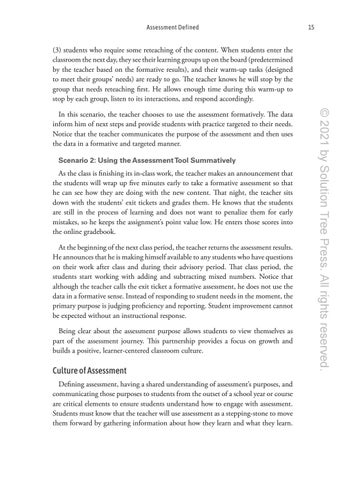Assessment Defined
15
(3) students who require some reteaching of the content. When students enter the classroom the next day, they see their learning groups up on the board (predetermined by the teacher based on the formative results), and their warm-up tasks (designed to meet their groups’ needs) are ready to go. The teacher knows he will stop by the group that needs reteaching first. He allows enough time during this warm-up to stop by each group, listen to its interactions, and respond accordingly.
Scenario 2: Using the Assessment Tool Summatively
As the class is finishing its in-class work, the teacher makes an announcement that the students will wrap up five minutes early to take a formative assessment so that he can see how they are doing with the new content. That night, the teacher sits down with the students’ exit tickets and grades them. He knows that the students are still in the process of learning and does not want to penalize them for early mistakes, so he keeps the assignment’s point value low. He enters those scores into the online gradebook. At the beginning of the next class period, the teacher returns the assessment results. He announces that he is making himself available to any students who have questions on their work after class and during their advisory period. That class period, the students start working with adding and subtracting mixed numbers. Notice that although the teacher calls the exit ticket a formative assessment, he does not use the data in a formative sense. Instead of responding to student needs in the moment, the primary purpose is judging proficiency and reporting. Student improvement cannot be expected without an instructional response. Being clear about the assessment purpose allows students to view themselves as part of the assessment journey. This partnership provides a focus on growth and builds a positive, learner-centered classroom culture.
Culture of Assessment Defining assessment, having a shared understanding of assessment’s purposes, and communicating those purposes to students from the outset of a school year or course are critical elements to ensure students understand how to engage with assessment. Students must know that the teacher will use assessment as a stepping-stone to move them forward by gathering information about how they learn and what they learn.
© 2021 by Solution Tree Press. All rights reserved.
In this scenario, the teacher chooses to use the assessment formatively. The data inform him of next steps and provide students with practice targeted to their needs. Notice that the teacher communicates the purpose of the assessment and then uses the data in a formative and targeted manner.




